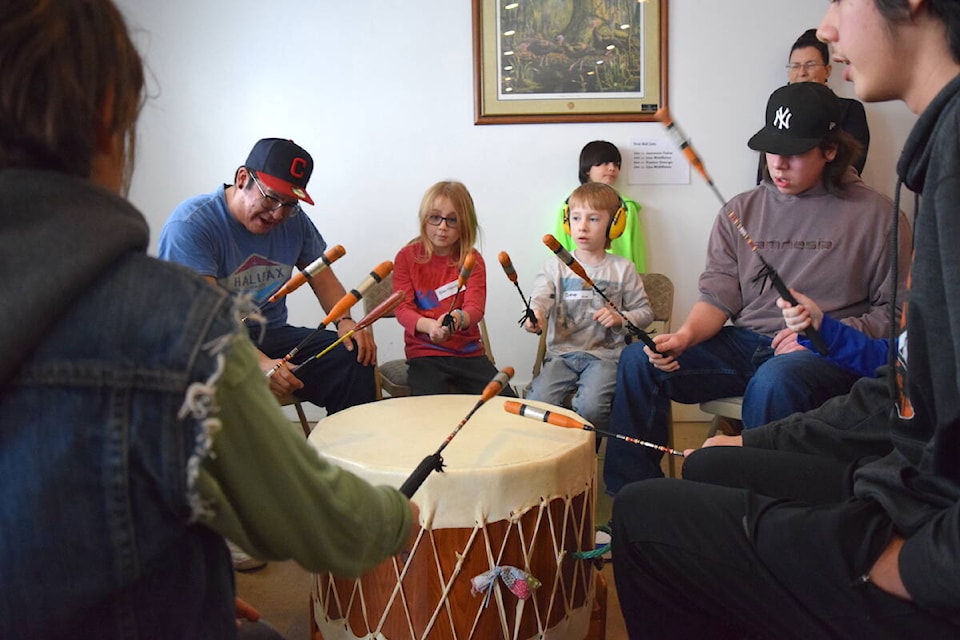Indigenous Grade 3 students were given an introduction to their own culture at a Primary Winter Gathering event assembled by Okanagan Public Schools on Thursday (Jan. 25).
Gathered at the �������� Game and Fishing Club facility in East ��������, the students were given an oral presentation by Westbank First Nation Elder Bonnie Coble along with presentations by the Birch Creek Drum Group and a group of nine adult and youth First Nations dancers from across the Okanagan outfitted in their traditional regalia.
Coble said the Primary Winter Gathering was a traditional event that brought together First Nations from across the Sylix territory for a two-week celebration, calling it a time for their people to come together, share wisdom, recognize authority and listen to one another with respect.
“Back then there were no cars or electricity. People came from great distances by horse or on foot and it would take a while to get back to their homes…so that is why these winter gatherings would last for two weeks,” Coble told the 60 Indigenous students at the event.
“It was a time to give thanks for all that we have and with our dancing and drums to send positive vibrations to our Creator, and share good things in our hearts.”
Christie Russell, the school district vice-principal of Indigenous education, said this is the tenth annual Primary Winter Gathering for students, which provides another opportunity for them to feel pride and learn more about their culture, to celebrate and recognize who they are and where they come from.
“It’s a chance to tell them what it means to be Indigenous,” Russell said.
She said the gathering was the first of four similar events that will involve more than 260 Indigenous students.
Russell said Thursday’s event also included a Grade 3 group from Revelstoke, as Indigenous education officials there heard about it happening and asked to participate “because nothing like that is happening in their community for young Indigenous students.”
She said Grade 3 students were chosen to be the focus of the winter gathering activities because that is the age where youth begin to formulate ideas about their identity, from a cultural and personal viewpoint.
“This gives them an opportunity to make a deeper dive into who they are as a culture and where they came from,” Russell said.
While it is a far cry from how generations of Indigenous youth were treated and educated in the residential school system, the winter gathering also represents a clear pathway forward to revive and learn from Indigenous culture, a mindset that has been championed by the Central Okanagan School District for more than 20 years.
Simone Gautier, who works with Indigenous education for the school district, recalled 23 years ago when she was one of eight people dedicated to the cause in direct or advisory roles. Today, that number is closer to 90.
“It is all about supporting the kids,” Gautier said. “We feel our Indigenous education is the best program in the province.”
School trustee Julia Fraser said she is consistently amazed when attending school trustee events in B.C. and across Canada to hear about Indigenous education prototype programs which already are in place for Central Okanagan students.
“I feel we do lead the charge in that regard. We are a trailblazer and a lot of the credit for that goes to Terry and her team,” said Fraser.
The ‘Terry’ she refers to is Terry Beaudry, the deputy superintendent of Central Okanagan Public Schools, who has been a driving force behind the Indigenous education initiatives which began in 2002.
Jessie Bruce, the acting director of instruction for Indigenous education and equity in the school district, said his department staff and advocacy supporters all share a passion for what they are doing.
“Their whole hearts are dedicated to this…it is important what they are doing because it helps position young Indigenous students to find success in their lives,” Bruce said.
Fraser cites one clear example of that positive turnaround – in 2002 the Indigenous youth graduation rate was 30 per cent; the six-year completion rate for 2016 to 2022 was 86 per cent which exceeded the provincial average of 75 per cent.
“It is just amazing to see that change,” she added.
For Russell, her involvement takes on a personal level as well since her mother is Metis.
“It did not have these cultural opportunities as a child so for me what we are doing here is really meaningful,” she said.
“We hope the kids leave here having had another opportunity to return to their classrooms and schools with a greater sense of pride for who they are and where they come.”
For Beaudry, the graduation rate achievement and other Indigenous education initiatives all reflect the school district’s ongoing commitment to the Truth and Reconciliation process, which so far has seen only 13 of the 94 calls to action so far being achieved on a national level.
READ MORE: Westbank First Nation and regional district’s first step to inclusive governance
READ MORE: Sawmill closure ‘dire’ for Fraser Lake and its Indigenous communities: chiefs



